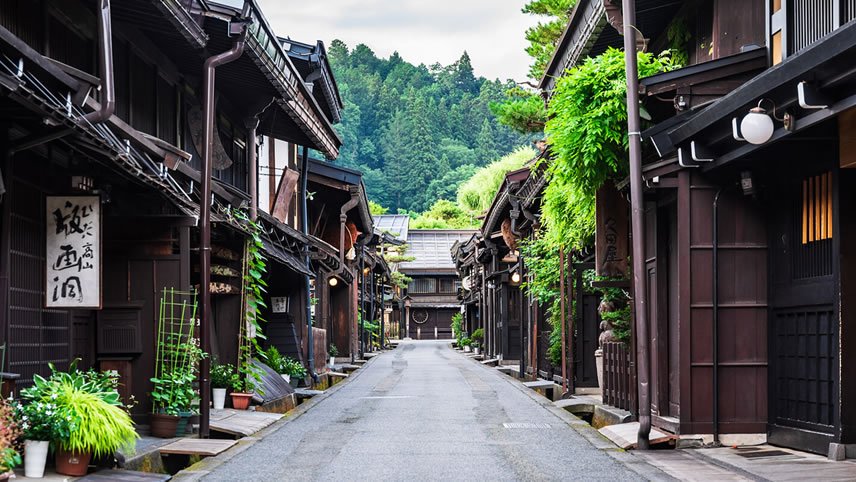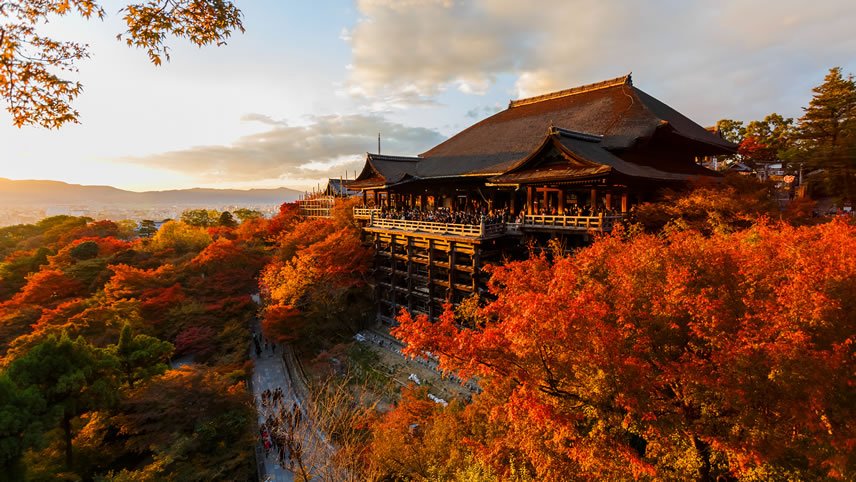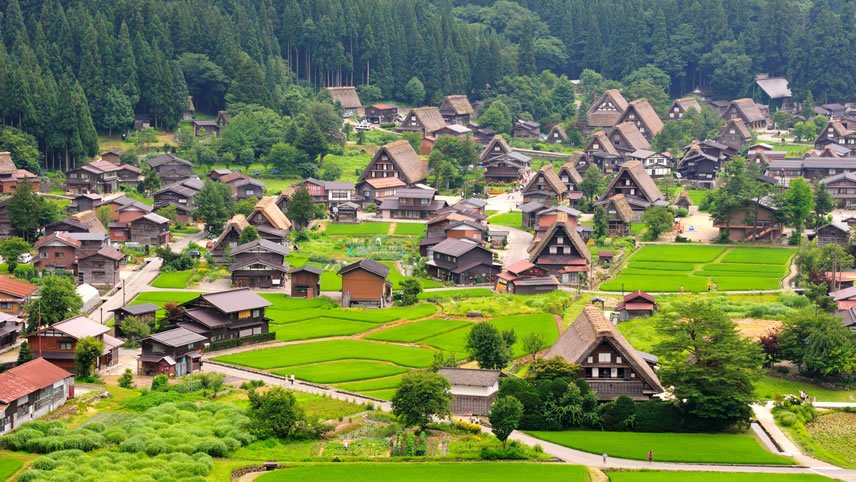Overview
Itinerary
Welcome to Japan, a country that combines the ultra-modern with the ultra-traditional in such a way that it seems completely natural. We begin in Tokyo, Japan's buzzing capital city. Formerly known as Edo, a small local fishing village, the Tokyo of today is a vibrant metropolis renowned for its advanced technology and diverse fashion sense, intermingled with the ancient traditions of Japanese culture.
We don't want you to miss out on any aspect of your small group tour. To ensure that you don't, we recommend you arrive by 5.30pm for dinner at the hotel with the guide. For those arriving in the evening and unable to attend the dinner, we'll meet you the following morning when our touring begins as we start exploring Tokyo. Please refer to the letter you received upon check in with further details on the start time and your guide's information.
One of the world's main economic centres, Tokyo is a city that presents a different view of itself at every turn. Starkly modern, it becomes a jewel box at night with a glittering display of neon and fluorescent lights. But you can retreat to quiet residential back streets or sculptured gardens and still find the harmony, scale and simplicity the Japanese have prized for centuries.
Our day begins with a visit to the scenic and spacious Imperial Palace East Garden, which provides a calm oasis amid the bustle of Tokyo. The garden is the former site of Edo Castle's innermost circle of defence. As none of the castle's main buildings remain today, the garden has been created in their place.
This afternoon we'll stroll through the shopping district of Ginza and experience the hustle and bustle of Shibuya, one of Tokyo's busiest districts, and home to the famous Shibuya crossing. Approximately 3,000 people can make their way across the intersection at any one time!
This evening we board a Yakatabune, a typical Japanese-style houseboat from the Heian Era, where we'll enjoy our highlight welcome dinner as we cruise along Tokyo Bay. Have your cameras ready, the views of the city skyline from the bay are really something!
Tokyo's downtown Shitamachi district is home to an array of sights, culture and a wonderful mix of old and new. We'll explore the district using the extensive subway network today, starting this morning at the impressive Asakusa Sensoji Buddhist Temple that dates back to the 7th century. Incense burns at the temple to purify and act as a strong form of spiritual offering, or as a way to carry one's prayers to heaven. Watch as locals and tourists alike purchase bundles of incense (osenko), light them, let them burn and fan the smoke towards themselves. It is said to have healing powers!
We'll also stroll Nakamise Street which is full of quirky shops and local snacks. Don't miss trying some of the interesting ice cream flavours on offer.
Special Experience: Delight in an entertaining sumo wrestling show while savouring a traditional Chanko-Nabe (a sumo hotpot-style stew) lunch. We'll spend the remainder of the day at leisure.
Hakone, part of the Fuji-Hakone-Izu National Park, is less than 100 kilometres from Tokyo and one of the most popular destinations among Japanese and international tourists looking for a break from the big city. It is famous for its hot springs, outdoor activities, natural beauty and the view of nearby Mt Fuji.
This morning we'll visit a former farming village, Iyashi-no-Sato Nenba. After being destroyed by a typhoon in 1966, the village was reconstructed and reopened forty years later as an open-air museum and traditional craft village, complete with restaurants, shops and galleries.
We'll then arrive in the mountainous town of Hakone, where we'll enjoy a cable car ride on the Hakone Ropeway and see incredible views of the iconic Mt Fuji (weather permitting). We will stop along the Hakone Ropeway and see the magnificent Owakudani Valley, created about 3,000 years ago when the Hakone Volcano last erupted.
Tonight, we'll be staying in an authentic ryokan guesthouse, where we'll sleep on traditional Japanese-style bedding, this unique style of accommodation features tatami mats on the floor. We will also have the chance to bathe in a natural onsen (hot springs) and enjoy a traditional Japanese dinner.
Located in Gifu, Takayama is a relatively small yet traditional city with an abundance of old inns, shops and sake breweries. Takayama is a city best known for its background in carpentry; it is believed Takayama craftsmen worked on the Imperial Palace in Kyoto and on many of the temples in Kyoto and Nara. Its elevated location and relative isolation allowed Takayama to remain relatively untouched by outside influences for a 300-year period.
We'll make our way to Takayama via the rail network starting with the bullet train and then connecting with a regional service for the final journey into Takayama Station. Upon arrival in the city, we'll explore the narrow streets of the beautifully preserved Old Town on foot. We'll see Takayama Jinya, a traditional Japanese building dating back to 1816, before making our way to the Sanmachi Suji District. The quaint streets of the district are lined with old-style merchant houses that date back to the Edo and Meiji periods. Today, these houses are used as sake breweries, shops and restaurants.
One of the biggest morning markets in Japan, the Miyagawa Open Air Market is a feast for the senses. Located on the banks of the Miyagawa River, we'll wander the many stalls, and check out the range of fresh fruit, vegetables, spices and local souvenirs on offer this morning.
Next, we'll visit the UNESCO World Heritage-listed site of Shirakawa-go, famous for its gassho-zukuri thatched-roof farmhouses characterised by their extremely steep roofs, some of which are more than 250 years old. Gassho-zukuri means ‘constructed like hands in prayer', as the farmhouses' roofs resemble the hands of Buddhist monks in prayer. This architectural style, developed over many generations, was designed to withstand the large amounts of heavy snow that fall during winter. We'll visit one of the gassho-zukuri farmhouse in the town, where one of the town's wealthiest families once lived.
We'll then observe the traditional art of Japanese Washi papermaking in Gokayama. Some artists enjoy working with rice paper because of its distinct texture and slight translucent appearance. Rice paper, or Washi as it is known, is commonly used in the traditional paper-folding art of Origami, practiced since the early 1600s.
Kyoto, one of Japan's most beloved cities is our destination today. This ancient city was the imperial capital of Japan for 1,000 years with the Emperor residing in its elaborate palaces. Considered the country's spiritual capital, Kyoto is graced with an abundance of temples, pavilions, gardens and museums. While there are many keen tourists looking to imbibe the serenity that Kyoto exudes, it is still possible to find a peaceful moment to personally connect with your surrounds.
All aboard Japan's famous rail system for our journey to Kyoto. Upon arrival we'll delve into the unique craft of sake brewing.
Special Experience: Enjoy a tasting experience at a local sake brewery in Kyoto and learn how Japan's drink of choice is made. Later today we'll explore the incredible tunnel of orange Torii Gates that make up Kyoto's famous Fushimi Inari shrine, dedicated to the god of rice and sake in the 8th century. Its resplendent orange Torii Gates are a sight to behold, numbering more than 10,000 as they wrap themselves around the base of the Inari Mountain.
We'll delve further into the delightful Japanese culture today. A morning walk along Philosopher's Path is a tranquil start to our day of exploring Kyoto. Named after Nishida Kitaro, one of Japan's most famous philosophers who meditated along the path while walking to university every day. The path is an enchanting and peaceful place in the city.
Special Experience: Delve into the stunning art form of Japanese black ink calligraphy and try your hand at perfecting this ancient art. Afterwards, we'll experience a Japanese tea ceremony. In Japan it can take years to master the art of the tea ceremony, the art form of cha-no-yu. With many distinct styles, the different configurations of tatami (straw floor mats), utensils and temae (the preparation), the hanging scrolls selected with attention to the season and theme, and the chabana (floral arrangement) are all purposefully chosen to infuse meaning into the ceremony.
The remainder of our day is free to enjoy at leisure.
This morning our first stop is the stunning Kinkaku-ji Temple (Golden Pavilion), an exemplar of traditional Japanese architecture. The temple's top two floors are completely covered in gold leaf and the pavilion is set amongst beautiful gardens.
Special Experience: Partake in a hands-on tofu and shichimi (Japanese seven-spice blend) making session, followed by a delicious lunch featuring creative obanzai dishes. After our immersive lunch experience we'll make our way back to the hotel and enjoy the rest of the day at leisure.
Hiroshima, a symbol of the utter devastation of war continues to build its reputation today as a symbol of peace. When the first atomic bomb exploded over Hiroshima on 6 August 1945, the city was obliterated. This moving city is our destination today.
We start our final day in Kyoto with a visit to the Togetsukyo Bridge, or ‘Moon Crossing Bridge', originally built in the Heian Period for nobles who enjoyed the natural surroundings. Next, we walk through the otherworldly Arashiyama Bamboo Forest, finding peace and tranquility as we stroll along the paths that wind through the towering bamboo stalks.
Later we'll tour the beautiful UNESCO World Heritage-listed Tenryu-ji Temple, ranked as the top of Kyoto's five great Zen temples, before enjoying a typical Buddhist lunch.
This afternoon, we travel to Hiroshima by bullet train.
The island of Miyajima lies just off the coast from Hiroshima and is renowned for its solitude, magnificent views and the Shrine of Itsukushima, built on wooden piers over the water. The shrine's Torii is out at the head of a bay and is one of the most photographed places in Japan. The giant Torii Gate seems to float on top of the water at high tide, its orange hue contrasting vibrantly with the blue of the surrounding water. We'll take the ferry to the island this morning and have some time to ourselves to enjoy this UNESCO World Heritage-listed site.
This afternoon we'll visit some of Hiroshima's important sites, including the Peace Memorial Park, the Atomic Bomb Dome, and the very moving Peace Memorial Museum, commemorating the dropping of the atomic bomb over Hiroshima.
A kaleidoscope of vibrant colour, traditions and culture, Osaka is Japan's second largest city. Formerly known as Naniwa, the city was Japan's first recorded capital city.
Our day begins with a bullet train ride to Himeji Castle. As Japan's largest and most-visited castle, it is regarded as the finest surviving example of Japanese castle architecture. UNESCO World Heritage-listed Himejijo, in its current form, dates back to 1617 and has remained intact despite extensive bombing during World War II and a great earthquake in 1995. We'll enjoy time at the castle and in the nearby beautiful Kokoen Gardens, a short walk from the castle's main gate.
This afternoon we'll make our way to Osaka and enjoy the rest of the evening at leisure.
Nara, in the heart of Japan's Kii Peninsula, is a city rich in history and culture, having served as Japan's capital during the Nara period before Kyoto. We'll begin our exploration of Nara with a visit to the ancient Buddhist temple of Todai-ji, also known as the Great Eastern Temple. Established in the 8th century, Todai-ji is home to the world's largest bronze statue of the Buddha Vairocana known as Daibutsu and is housed in the Great Buddha Hall (Daibutsuden), which itself is one of the largest wooden structures in the world!
Surrounding Todai-ji is the serene Nara Deer Park where friendly sika deer roam freely. We'll have the chance to explore the picturesque park and even purchase deer crackers to feed the deer. Considered sacred messengers of the gods, these deer are a symbol of the city and have a protected status.
Heading back to Osaka we'll have some free time for lunch and a spot of shopping in the vibrant Dotonbori district.
Special Experience: Dive into the world of pre-modern Japan with a fun, interactive session on the way of the Samurai. Unleash your inner warrior as you learn their legendary skills. Many Samurai lived by the concepts of loyalty to one's master, self-discipline and ethical behaviour. They were also adept with the bow and sword. We'll learn about the art and try out the movements ourselves, definitely resulting in a few laughs!
Tonight, we'll enjoy a Japanese-style group farewell dinner.
Our tour concludes after breakfast this morning. We hope you leave with fantastic memories!
Trip Inclusions
- Visit Imperial Palace East Garden
- Stroll through the Ginza District
- Experience Shibuya Crossing
- Admire the city lights of Tokyo Bay while on a dinner cruise
- Tokyo sightseeing including Asakusa Sensoji Temple and Nakamise Shopping Arcade
- Enjoy a sumo wrestling demonstration and a traditional Chanko Nabe lunch
- Visit a former farming village, reopened as a museum
- See Mt Fuji while riding the Hakone Ropeway (weather permitting)
- Spend a night in a traditional ryokan guesthouse
- Take in the sights of historic Takayama by foot
- Free time to explore Miyagawa Open Air Market
- Wander through Shirakawa-go, with its famous gasshō-zukuri thatched roofs
- Learn about the Japanese tradition of washi papermaking in Gokayama
- Sample the famous sake beverage
- Tour the Fushimi Inari Shrine
- Stroll the Philosopher's Walk
- Take part in a black ink calligraphy class
- Experience a traditional tea ceremony in Kyoto
- Visit Kinkakuji Temple (Golden Pavilion)
- Enjoy a tofu and shichimi making lesson
- Stroll through the Arashiyama Bamboo forest and see the Togetsukyo Bridge
- Enjoy a Buddhist lunch at Shigetsu (Tenryuiji Temple)
- Visit the island Miyajima and see the giant Itsukushima Torii Gate (currently under maintenance)
- Tour the Hiroshima Peace Park, and visit the Atomic Bomb Dome and the very moving Peace Memorial
- Visit Himeji Castle
- Explore the Todai-ji Temple
- Feed the deer in Nara Deer Park
- Free time to explore Osaka's Dotonbori District
- Learn the way of the Samurai in Osaka, Japan's pre-modern warriors
- Return economy-class flights from Australia to Japan. Taxes included
- Airport transfers on the first and last day of tour
- All touring in air-conditioned vehicles
- 4 bullet train journeys in Japan
- 2 Limited Express train journeys in Japan
- Tipping is not part of the Japanese culture, so tips are not expected
- 12 nights in 3-4 star hotels
- 1 night in a traditional ryokan guesthouse, Hakone
- Shinagawa Prince Hotel, Tokyo
- Hakone Yunohana Prince Hotel, Hakone - Japanese Style Ryokan accommodation
- Hida Hotel Plaza, Takayama
- Miyako Hotel Kyoto Hachi Jo, Kyoto
- Sheraton Grand Hotel Hiroshima, Hiroshima
- Sheraton Miyako Hotel, Osaka
Hotels listed are an indication and are subject to change without notice.
- 13 breakfasts, 3 lunches and 5 dinners, including group welcome and farewell dinners
- One of the best ways to experience a destination is through its cuisine, and in Japan, food holds deep cultural significance, reflecting centuries of tradition.
- With this in mind, it should be noted that dietary requirements – including but not limited to vegetarianism, veganism, gluten-free/coeliac diets and some allergens – are less common and may not always be accommodated.
- The restaurants and experiences visited on our Japan tours will not always be able to alter their menus to fully exclude specific allergens or to cater for strict dietary requirements, and it should also be noted that meals for those with specific dietary requirements may be simpler and less varied. Cross contamination cannot be catered for in all of our restaurants and experiences we visit, therefore it is up to the individual traveller to manage their own allergens.
- While your Bunnik Tour guide will make every effort to inform you of the main ingredients in the dishes, the ultimate responsibility rests with you to ensure that you avoid any problematic ingredients.
- English-speaking locally based national guide
- Accommodation, itinerary and inclusions subject to change.
- Disruptions to itinerary may occur.
- Should you not be travelling on the group tour flights shared bus transfers will be used between the hotel and the airport for the departure transfer.
- On days 6 and 11 we will be travelling by bullet train and our luggage will be transferred via coach. We will need to pack an overnight bag with two night’s worth of luggage. Unfortunately, bullet trains have very limited space for luggage.
- From June 2019, Miyajima's famous floating Torii Gate is undergoing renovations. During the renovation works, the Torii Gate will be covered under partially transparent scaffolding. A bridge is being built on the left side of the gate to aid the renovation works.
- If you are travelling on or around the holidays of Golden Week (29 April to 5 May) heavier traffic conditions and longer waiting times can be expected.
- Women may need a head scarf to enter some mosques and temples, and wear modest clothing that covers knees and shoulders. Also, a good tip is to pack a spare pair of socks in your daypack, as sometimes shoes need to be removed when entering and the ground can be hot.
- Japanese Cuisine - One of the best ways to experience a destination is through its cuisine, and in Japan, food holds deep cultural significance, reflecting centuries of tradition.
Trip Reviews (12) View All Most Recent 'Japan Discovery' Reviews
The accommodation was excellent as was the included meals and activities. We travelled by coach and trains including several times on a bullet train. As always Georgie from Global Journeys did an amazing job of organising another holiday ...read more for us. This was our second Bunnik tour and have another trip booked so I highly recommend them and Japan Discovery.
Our tour director was a very friendly gentle Japanese lady who did her best. Unfortunately, her communication skills were not good. Typically, she would speak at length explaining directions, history, etc and then the tour group would look at each other and comment if anyone had understood what she had just said. The group worked around this limitation by asking a lot of questions to try and fill in the gaps. This was stressful and frustrating at times. We also received little guidance on recommended things to do in our free time and we were mostly left to plan on our own.
The hotels were good and some exceeded our expectations. On several occasions we arrived late and did not have time to utilise the excellent facilities that were available. Overall, we rated the Bunnik Japan Discovery Tour at 7/10 and feel that it was expensive for what was included.
The weather in late March was cool but good for walking. Highhlights were seeing a snow covered Mt Fuji emerge from cloud and our first cherry blooms along the river of the Philosophers walk in Kyoto. Returning to our hotels each evening was a treat as they were well located for cafes and restaurants and very comfortable. We rate this tour as 5 star and thank Yoko and Bunnik for all the magic and fun experiences.
knowledgable, ...read more friendly and welcoming.
Tips: Take lots of socks in case it is raining when you have to take shoes off and on. Take slip on shoes. Pack an umbrella. Use Google Interpreter to help with language.
One trip highlight was seeing Mt Fuji because we struck very cold, wet, cloudy weather. Our group thought we would miss out but the weather cleared and there it was . Beautiful. Loved the Alps and ryokan. Blossoms were not out in Tokyo but were in Hiroshima and Osaka. Thought we were going to be unlucky but we saw some beautiful blooms. Also the castles and temples were lovely. Japanese people so polite and friendly. Thanks to our guide a lost shoulder bag and all contents was located and sent on to hotel in a day or two. Cities clean, quiet and orderly. Food interesting! Amazing toilets! Our tour was fast paced and the guide was excellent. 18 people in group, all well travelled and fun. We certainly had a great trip.

Prices & Dates
There are currently no departures available on this trip. Either it's the end of the season and new departures will be released shortly, or this itinerary has been changed and will no longer continue. Feel free to contact us for information about when next seasons dates will be released or click here to view the general release dates for all destinations.
Tour & cruises prices are per person. Prices shown have savings applied, are subject to availability and may be withdrawn at any time without notice. Pricing and trip details are correct at this point in time, however are subject to confirmation at the time of booking and are subject to change by Bunnik Tours. For cruise itineraries, cabin images are sourced from Bunnik Tours. These should be treated as indicative only. Cabin inclusions, upholsteries and room layout may differ to the image(s) shown depending on the ship selected and your sailing dates.





